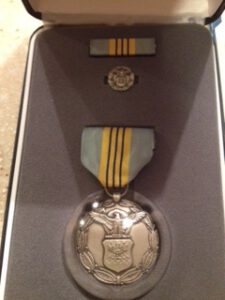University of Utah mechanical engineering professor and chair Bruce Gale, whose research in microfluidics has been spun out into numerous companies and led to 22 US patents, was elected as a fellow of the National Academy of Inventors (NAI).
Professor GALE Talks on “Microfluidics for Fertility.” at Bay Area Microfluidics Network
Mechanical Engineering professor Bruce Gale gave a talk on “Microfluidics for Fertility” at the virtual event of Bay Area Microfluidics Network held on October 7, 2021. The recording of the event is Here.
Alum Spotlight: BJ Minson (ME EN BS/MS 2013)
BJ Minson’s path to success included a fork in the road. Fortunate for many, the founder and CEO of GRIP6 Belt Company chose to simultaneously take both the right and the left roads. The road on the right would carry him toward cutting-edge mircrofluidics. The road on the left was to satisfy an itch, the kind you get when you feel something just isn’t right
(Pictured: After obsessing about Tesla for the past six years, Minson finally took delivery of his Model 3 last July. He was just a tad bit excited.)
As a master’s student, Minson was creating microfluidic chip designs and waiting for E. coli colonies to grow. But between rounds, his mind was on product design. He had an idea to use the CO2 laser in his lab to test out thin plastic belt buckle concepts. “I simply wanted a better belt, one that didn’t have holes, didn’t have a flap hanging off and wouldn’t stick out under my shirt,” he said.
Within a few weeks, the prototypes were taking shape and working well. Next, he began cutting out aluminum parts on the water-jet cutter in the advanced machine shop and giving them to friends to try out. The new buckle design worked well, and the feedback was encouraging.
After graduating with his master’s and still on his chosen career path, Minson began a job working as an engineer at Merit Sensor Systems. By day, he was designing new manufacturing techniques for high volume blood pressure sensors, and by night he was refining the design and manufacturing techniques for his new belt.
His best friend gave him $1,000 to purchase a few supplies so he could launch the belt on Kickstarter to test the viability of the product. With no marketing, the belt raised $106,000 in 30 days. When the number reached nearly 10,000 units, manufacturing them in his garage no longer seemed feasible.
“The advice I received at the time,” said Minson, “is that I would not succeed without making my products in China, but something bothered me about that. Why did so many people think it was impossible to make products domestically? Why should I have to rely on someone halfway around the world to be successful? After all, I had specifically designed the belt to be simple to both use and manufacture. After about the 10th time. someone said I would fail without China. I was determined to prove them wrong.“
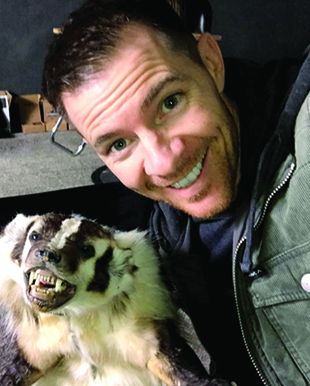
So GRIP6 was born in his garage. Minson buckled down and got friends and family to help him for free. Over the next several months, he purchased a few small machines, made several custom machines and pumped out belts and buckles. The labor and the long hours, in addition to a full day at work, made it a truly hellish experience, he said. However, the small team delivered on their promise and shipped GRIP6 belts all over the world.
BJ’s Tips For Engineering Students:
Be a project-oriented engineer. It’s critical to have a solid understanding of underlying principles, but you also have to move beyond the theory and get experience building physical things by hand. My most valuable engineers are the very diverse and adaptable type. They can’t help but work on their own projects on the side. They love learning and doing. School projects and personal projects and extremely valuable catalysts for learning and becoming valuable as an engineer.

Interesting things: Fun facts about BJ:
- BJ is obsessed with anything related to Elon Musk, Tesla and SpaceX.
- BJ coaches a small First Lego League team consisting of his daughters and nephews.
- BJ designs and builds electric scooters with and for his kids every summer.
- BJ cuts his own hair.
- BJ actively encourages engineering among youth; GRIP6 held its first annual “Engineering Day” for kids last summer, and plans to expand it in 2019 and beyond.
Sant Receives NIH Microsurgical Innovations Grant
Mechanical Engineering Research Assistant Professor Himanshu Sant, received a $235,435 grant from Microsurgical Innovations (Prime sponsor NIH), for his research, “A Biodegradable Vascular coupling Device for End-to-End Anastomosis.”
Gale Receives Mayo Clinic Grant
Mechanical Engineering professor Bruce Gale received $67,750, from the Mayo Clinic for his research, “Development of a Whole Genome Amplification (WGA) Cell Analysis and Selection Instrument.”
3D Printing Human Ligaments, Tendons and More . . .
With today’s technology, we can 3-D-print sculptures, mechanical parts, prosthetics, teeth, even guns and food. But a team of University of Utah biomedical engineers have developed a method to 3-D-print cells to produce human tissue such as ligaments and tendons, a process that will greatly improve a patient’s recovery.
A person with a badly damaged ligament, tendon, or ruptured disc could simply have new replacement tissue printed and ultimately implanted in the damaged area, according to a new paper published in the Journal of Tissue Engineering, Part C: Methods.
“It will allow patients to receive replacement tissues without additional surgeries and without having to harvest tissue from other sites, which has its own source of problems,” says University of Utah biomedical engineering assistant professor Robby Bowles, who co-authored the paper along with former U biomedical engineering master’s student, David Ede.
The 3-D-printing method, which took two years to research, involves taking stem cells from the patient’s own body fat and printing them on a layer of hydrogel to form a tendon or ligament which would later grow in vitro in a culture before being implanted. But it’s an extremely complicated process because that kind of connective tissue is made up of different cells in complex patterns. For example, cells that make up the tendon or ligament must then gradually shift to bone cells so the tissue can attach to the bone.
“This is a technique in a very controlled manner to create a pattern and organizations of cells that you couldn’t create with previous technologies,” Bowles says of the printing process. “It allows us to very specifically put cells where we want them.”
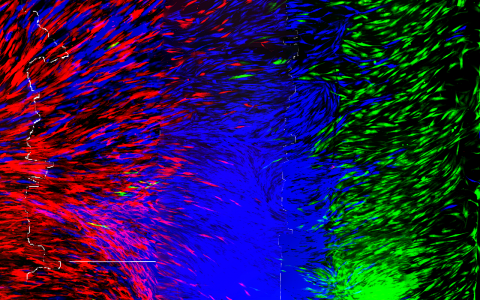
To do that, Bowles and his team worked with Salt Lake City-based company, Carterra, Inc., directed by mechanical engineering professor and chair Bruce Gale, which develops microfluidic devices for medicine. Researchers used a 3-D printer from Carterra typically used to print antibodies for cancer screening applications. But Bowles’ team developed a special printhead for the printer that can lay down human cells in the controlled manner they require. To prove the concept, the team printed out genetically-modified cells that glow a fluorescent color so they can visualize the final product (pictured, below).
Currently, replacement tissue for patients can be harvested from another part of the patient’s body or sometimes from a cadaver, but they may be of poor quality. Spinal discs are complicated structures with bony interfaces that must be recreated to be successfully transplanted. This 3-D-printing technique can solve those problems.
Bowles, who specializes in musculoskeletal research, said the technology currently is designed for creating ligaments, tendons and spinal discs, but “it literally could be used for any type of tissue engineering application,” he says. It also could be applied to the 3-D printing of whole organs, an idea researchers have been studying for years. Bowles also says the technology in the printhead could be adapted for any kind of 3-D printer.
3D Printing of Tendons and Ligaments
U Profs Receive $16M to Launch New MEP Center
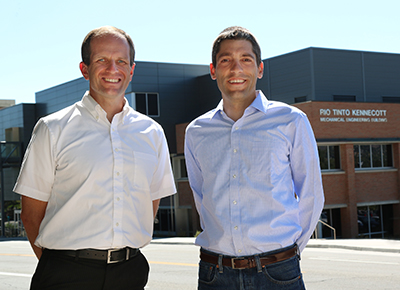 Mechanical Engineering associate professor Bart Raeymaekers and professor Bruce Gale receive $16 million in funding over the next five years from both federal and state governments as well as local industry to develop a new center to help local manufacturing businesses succeed.
Mechanical Engineering associate professor Bart Raeymaekers and professor Bruce Gale receive $16 million in funding over the next five years from both federal and state governments as well as local industry to develop a new center to help local manufacturing businesses succeed.
One of the hot-button issues this presidential election is about companies outsourcing work overseas and figuring out how to keep manufacturing jobs here in America. To help convince these businesses they can perform better in their own backyard, two University of Utah mechanical engineering professors are establishing a center to show local manufacturing companies how they can spur innovation and utilize the latest in technology.
The new University of Utah Manufacturing Extension Partnership (MEP) Center will deliver services for small and medium-sized manufacturing companies by providing expertise in advanced manufacturing technology, innovation, worker education, operational excellence, and on how to connect companies with investor opportunities.
“The goal of the program is to provide these services so businesses can remain competitive against cheap overseas labor and to keep those manufacturing jobs here,” says University of Utah mechanical engineering associate professor Bart Raeymaekers, who along with mechanical engineering professor Bruce Gale are creators of the center and recipients of the grant.
The center, in partnership with other entities and organizations throughout the state, will help local businesses:
- Use data to identify products and markets that are growing and provide resources for the prototyping of new products.
- Implement advanced manufacturing equipment and technology.
- Develop and educate their workforce to use these new technologies.
- Connect with investors and secure government grants to increase funding.
- Learn how to make their operations more efficient to maximize profits.
The University of Utah’s MEP Center will receive funding from the U.S. commerce department’s National Institute of Standards and Technology (NIST) and the Utah Governor’s Office of Economic Development (GOED). All told, the center will receive $16 million in funding over the next five years from both federal and state governments as well as local industry. Utah is one of 11 states and Puerto Rico to have received NIST funding this month for local MEP centers.
The Utah center, which will be under the U’s College of Engineering, will begin operations Oct. 1 and be headquartered on the U campus. It will employ at least a dozen permanent employees, consultants and industry professionals. It will open satellite offices in Cache and Utah counties as well as have consultants in eastern Utah and Cedar City.
There are more than 3,300 manufacturing companies in Utah, ranging in areas from chemical products and computer and electronic products to metals, aerospace equipment and food products, according to publicly available data.
NIH Features U Student Research
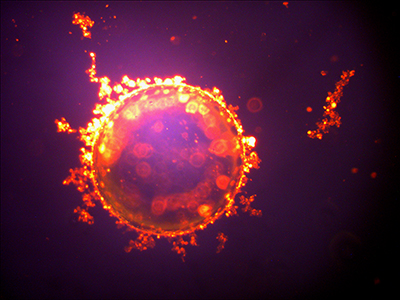
NIH – Snapshots of Life: A Flare for the Dramatic: Oil and water may not mix, but under the right conditions—like those in the photo above—it can sure produce some interesting science that resembles art. You’re looking at a water droplet suspended in an emulsion of olive oil (black and purple) and lipids, molecules that serve as the building blocks of cell membranes. Each lipid has been tagged with a red fluorescent marker, and what look like red and yellow flames are the markers reacting to a beam of UV light. Their glow shows the lipids sticking to the surface of the water droplet, which will soon engulf the droplet to form a single lipid bilayer, which can later be transformed into a lipid bilayer that closely resembles a cell membrane. Scientists use these bubbles, called liposomes, as artificial cells for a variety of research purposes.
Alum Receives Second Highest Civilian Award from Air Force
For his steadfast dedication to the mission of the Space Superiority Systems Directorate, Mechanical Engineering alum, Mark Eddings B.S.’04, received the Meritorious Civil Service Award, from the Los Angeles Air Force. Noted was the the fact that many of the advances over the past two years were spearheaded under Dr. Eddings’ leadership.
The Meritorious Civil Service Award is the second highest award a civilian can receive in the Air Force. This is especially remarkable when considering Mark has only worked for the Air Force for five years.
Mark A. Eddings was born and raised in Bountiful, Utah. He attended Bountiful High School where he graduated in 1997. After serving a two-year LDS mission to the Fiji Islands, he returned home and began studying Mechanical Engineering at the University of Utah. He graduated in May of 2004 with a Bachelor’s Degree in Mechanical Engineering and received his PhD in Bioengineering.
Research work while working with mechanical engineering professor Bruce Gale in the Biomedical Microfluidics Lab include:
- Development of a painless drug delivery system using microneedles. The project utilized photolithography, wet etching, electroplating, and other MEMS processes.
- Development of micropumps for on-chip fluidic control for biosensors and protein spotting applications. Work was focused on PDMS-based peristaltic and permeation/diffusion pumps.
- Development of highly arrayed continuous flow immunoassays in a microfluidic device.
- Development of an ELISA assay for detection of antibodies to drug treatments given to Multiple Sclerosis (MS) patients.
The Department of Mechanical Engineering at the University of Utah is committed to providing students with broad-based, rigorous and progressive education. By combining state-of-the-art facilities with renowned faculty, the department provides an education that gives students the necessary skills to become the next generation of innovators.
Gale Named 2014 Distinguished Mentor
 Mechanical engineering professor Bruce K. Gale has been named a 2014 Graduate Student and Postdoctoral Scholar Distinguished Mentor by the University of Utah Graduate School. Gale was recognized during the 2014 College of Engineering convocation ceremony on May 2.
Mechanical engineering professor Bruce K. Gale has been named a 2014 Graduate Student and Postdoctoral Scholar Distinguished Mentor by the University of Utah Graduate School. Gale was recognized during the 2014 College of Engineering convocation ceremony on May 2.
The $2,500 award recognizes faculty for effectively guiding students and fellows through professional and educational training. Gale is one of three award recipients this year, along with Matthew Mulvey (pathology) and Timothy W. Smith (psychology).
Engineering graduate students, postdoctoral scholars, alumni and colleagues nominated Gale for the honor, citing his devotion, appreciation for diversity and ability to individually tailor guidance.
“I am very honored and grateful to be nominated,” says Gale. “I am overwhelmed that so many thought so highly of my efforts, as there are many excellent mentors within the College of Engineering,” says Gale.
Gale was praised for his accessibility despite holding several university leadership positions, including director of the State of Utah Center of Excellence for Biomedical Microfluidics. He was also lauded for creating a supportive environment through weekly meetings that enable student researchers to present ideas and discuss barriers.
“Mentoring has helped me recognize the gifts and talents of many students, and that every student can make a contribution to science and engineering,” says Gale. “Recognition should also go to my great students and postdocs who make mentoring easy for me. I better appreciate the uniqueness and value of many more people, approaches and cultures.”
To receive the award, a mentor must have a record of guiding students to degree completion. Gale has graduated 13 Ph.D. and 27 M.S. students, advised six postdoctoral researchers and mentored dozens of undergraduates. He currently advises 11 Ph.D. and two M.S. students.


